Ten Little Mistresses: Kalog & Kabog Meet Thriller In Kabit Film Subversion
One glance at the trailer of Ten Little Mistresses and certain things become apparent: sosyal are these keridas, costumes are kabog, dialogue is kalog, and somehow their beloved drops dead during his own birthday party. Direk Jun Lana takes murder mystery out for a nakakalokang ride with Ten Little Mistresses after touchingly-funny flicks such as Die Beautiful and The Panti Sisters.
Not to mention, there’s certainly a mystifying quality when natural comedic talents such as Eugene Domingo (Ang Babae sa Septic Tank, Barber’s Tales) and Pokwang (A Mother’s Story, Mercury is Mine) become paired with the likes of drama specialists like Agot Isidro (Family Matters) and Kate Alejandrino (Respeto, Dormitoryo). With a trailer that teases a subtle subversion with comedy amid a murderous tragedy, it’s interesting how Direk Jun tackles a comedic thriller – especially in the context of Filipino cinema, with the added challenge of dressing it up like a “typical” kabit story.
It’s no surprise that the first Filipino Amazon Original Film spared no expense in bringing Direk Jun’s ambitions to life. Producer Percy Intalan and the Idea First Company transformed an otherwise “typically Filipino” comedy fest into a feast for the eyes and the ears – evident clearly in the trailer, and even more so within the film’s first minute.
Getting Comedy Out Of The Way
Doors burst open to mayor-doma Lilith (Domingo) directing her maids in preparing mansion of Don Valentin Esposo (Arcilla) for the arrival of his mistresses for his birthday, done so in a quasi-musical singing of “Sampung Mga Kerida” – a kerida-fied play on “Sampung Mga Daliri” with kalog language that makes clear the tone the film wants to take.
The Esposo estate maids’ “Sampung Mga Daliri” perhaps encapsulates precisely the way the film approaches its humor: it’s one thing for a song twist to forewarn things to come, and it’s a whole different level of savage for the song to make off-handed insults to its film’s main characters seconds before they arrive. And much like the keridas unbothered by this perception of their status, Ten Little Mistresses doesn’t hype itself as a comedy thriller despite its presentation.
As with other Jun Lana films, Ten Little Mistresses subverts expectations with the meta that February 15 is the Araw ng mga Kerida (Day of the Mistresses), and the keridas can’t be blamed if their level of wildness gets to the point of comedic exaggeration.
For a movie aiming to be the film “to end all mistress films,” Ten Little Mistresses achieves just that. It has an innate kalog charm that can excuse the whodunit’s rather straightforward (and maybe predictable) plot for the hilarity of unexpected (or rather, unfiltered) kalat.
At its core, the film is a thriller, and its characters just so happen to be hilarious.
It’s Meme Culture But In A Film
Humor in Ten Little Mistress is actively choosing to eavesdrop in a conversation after sitting down in a cafe, with the ungodly things you hear being karma making you wish you hadn’t just used your God-given talent of pagma-marites.
It’s meme culture at its rawest – Ten Little Mistresses delivers when a supposed punchline is delivered in such a nonchalant fashion, where there’s the expectation of retaining suspension of disbelief, and as though there’s a blatant refusal to question that somehow those words, in that order and combination, had just come out of someone’s mouth.
One knows the film also explores a different dimension of meta-humor when it knows it reaches incredulous levels of sabog, especially when even the characters question each other’s sanity with witty comebacks and inside jokes that viewers would eventually come to terms with – as though filmgoers are eventually integrated into their kerida club via exposure, and whether they like it or not.
Think of a comment in a Facebook post that is stereotypically Pinoy lutang that becomes second-handedly embarrassingly funny. Then imagine a drama veteran like Agot Isidro saying it with a straight face. You can’t just make this shit up.
It Could’ve Been Just Comedy
Despite how Valentin’s relationships with his keridas become both stereotypical and deep enough to warrant further examination, it’s the film’s approach to comedy that makes one question the need for a murder dimension at all. While the premise of the film’s concept had always been about murder mystery being one of Direk Jun’s longest fascinations, one can’t deny the sheer unexpected thrill in the rapport of the kabit with each other.
In fact, removing the murder mystery can still give the film a shining quality in the stage presence of the ensemble cast alone. There’s enough comedy to go around in terms of establishing each character’s “shtick,” with a more dramatic story possibly replacing the thriller element to cement the potential depth of their personalities better.
But then again, such a concept could transform the film into standard fare comedy drama. So just like what any of the kabit would probably say, I’ll stay over in the gedli.
Vibrance And Exaggeration
After “Sampung Mga Kerida” ends with an abrupt cut, a noteworthy drone shot of limo after limo lining up along the driveway of the ginormous Casa Esposo establishes the sheer grandeur of Don Valentin’s wealth – perhaps to ridiculity, a point each kerida establishes with an appropriately disproportionate display of kalat.
While not as powerful an opening as viewers would expect, each scene’s overemphasized establishing shots still make for a relatively “tame” introduction to the wildness of encounters with each mistress.
Legs sprout from each limousine as a bolder rendition of Maymay Entrata’s “Amakabogera” blares on each speaker, announcing the introduction of each kabogerang kerida. And kabog they go – nameplates flashing alongside each mistress as they step out in their full glory, costumes and headdresses almost ballooning the screen in arc shots rivaling MET Gala appearances.
Each kerida steals the camera for a few seconds of fame, appropriate to Maymay Entrata’s “Lalakad na ala-beauty queen, awra ko’y will make you scream.” With the roaring lines building up to face-offs between each mistress with glares and tarayan and irapan, blatant is the declaration of boundaries and rivalries for viewers to notice. And with each ba-thump-thump-thump of the rendition’s instrumental blaring in the distance, one couldn’t help but feel sinfully excited for the potential catfights ahead. It’s bound to happen – it’s a mistress film.
Editor’s Note: As to why Maymay Entrata, whose line in her own song “amakabogera, umaapaw ang karisma” perfectly describes her natural talent for dramatic comedy, wasn’t cast for any of the roles is a bit of a letdown – especially with the number of obscure references in the film anyway.
A pattern of exaggerated exposition, momentary elucidation, and deliberate destruction become a thematic focus of the film – something production takes to heart with cinematography (with no blatant “it’s deep so it’s cool” pa-epeks) and visuals from one scene to the next.
It’s after the “Amakabogera” segment ends with an eksaheradang animosity group shot that the apparent stereotypical attitudes of keridas go full display, echoing “Sampung Mga Kerida” just minutes earlier: “walang hiya, walang modo-“ and with the group shot as though asking viewers, “-yan ba ang gusto niyo?”
Kerida Stereotypes Take Flight
In a film with an ensemble cast already known for their powerful comedic drama performances, it could’ve been quite a challenge for Direk Jun to ensure each kerida was able to establish their respective personalities even with the shortest of shots.
Each kerida has personalities built to compete in occupying the space of even the largest of settings, with the mistresses trying to outwit and outpace each other in efforts to “steal” the show across sprawling sets.
An ordinary foyer transforms into a busy cocktail venue, a poolside becomes the site of an obligatory dance number, and even an inconspicuous garden becomes the site of an open forum.
No wonder the film needed an entire resort to contain the level of energy of each kerida – and all seemingly intentional. This is especially when considering how each kerida pairing seemingly played off a satirical take on the kabit tropes in Filipino stories.
Magenta v Babet: The One With The Stakes
Perhaps the most “realistic” among the caricature-like takes on the kabit would Magenta (Martin) and Babet (Pokwang), revealed to be the first two (2) keridas of Valentin Esposo. While not opposites of each other, they do characterize the witty banter between rivaling lovers – to the extent that their existence as keridas has become second nature to them. Magenta tries to win over Valentin with ballooning bosoms and a white gown fitting for the assumerang bride, immediately taking over a room with her charisma and “authority” based on superiority. Babet bites back with fiercer outfits, her most iconic one being a golden dress with dragons for shoulder blades, as though reflecting her no-holds-barred persona.
Materialistic Magenta is similar to Maita (Glydel Mercado) of 1999’s Mister Mo, Lover Ko whose aspirations rest largely on what she could gain from a prospective marriage. Meanwhile, dragonessa Babet is akin to Diosa (Sharon Cuneta) of 1991’s Una Kang Naging Akin, who’s accepted the life of being an unexpected kabit as her feelings for her man remain true despite her situation.
Among the interactions of the kabit pairings, it would be Magenta and Babet’s that seem to be the one found in the usual mistress story. While Magenta and Babet’s banter falls largely on back-and-forth jabs, one couldn’t help but sympathize with how desensitization to their status as kabit throughout the years would’ve forced the two (2) to coexist.
Doc Helga v Diva: The Apprentice Versus The Mentor
Immediately noticeable from the “Amakabogera” entrance would be Doc Helga (Isidro) and Diva (Bernal) wearing almost the same outfit – down to ridiculous headdresses – with just slightly different color values. This “one is possibly the gaya-gaya/impostor” extends even to their interactions, with Diva often seen mirroring Helga in both statements and actions regardless of the spotlight on them.
It’s eventually revealed that Diva is the surgically-beautified former assistant of renowned plastic surgeon Doc Helga, whose stoic treatment of her status as a kerida was by choice. In the doctor’s own words: anger is not worth ruining an expensive retoke.
While still prone to snapping at the sometimes-airheaded former assistant, Helga and Diva’s mirroring banter is an exaggeration of the “mistress being a younger copy of the wife” trope.
Television fans would see this story approach most recently with Ika-6 Na Utos, where voluptuous but streetsmart Georgia (Ryza Cenon) seduces the husband of her best friend, the business-savvy legal wife Emma (Sunshine Dizon). While Emma and Georgia often resorted to witty exchanges and with the historic showdowns here and there (yes, that water gun scene), their verbal encounters devolved into an “everyday occurrence” – a “coexistence” of sorts that Helga and Diva also showed in Ten Little Mistresses.
Sparkle v Because: It’s All About X-Factor
Representing the more “carnal” of the kabit stereotypes would be the “rivalry” between Sparkle (Alejandrino) and Because (So), two (2) rather popular models whose control over both their diction and walk make evident why Valentin chose them in the first place: the sins of the flesh.
When Coco tells Moon Young that their environment reeked of “regression,” it’s Valentin and his relationship with Sparkle and Because that seemed to represent this in its physicality. The two (2) damsels give a satirical take on the “hot mistress” trend in most kabit media, something also parodied by the likes of Gloria Martinez (Rufa Mae Quinto) in 2005’s comedic Mano Po 4: Ako Legal Wife.
In Ten Little Mistresses, the conflict between Sparkle and Because reveals their rivalry extends even before Valentin. Both pageant-goers, it’s Because who skyrocketed into social media fame due to her catchphrase “Because?” (like the worn out slogan), which is something that constantly irks the seemingly more intellectual Sparkle.
One can’t be blamed to think that pageant-goers such as Sparkle and Because surely possess enough foresight to know dealing with a married man is a bad idea. Then again, it’s much easier to put blame when outside of any given situation. And more importantly, their persistent bickering gives a horrifying indication that Valentin knew what made them tick to keep them in his grasp: Sparkle’s pride overtaking her common sense, and Because’s naivete preventing her from using hers.
Whodunit Takes A Step Back
Direk Jun Lana accompanied the stars (sans Arci Munoz) in the world gala premiere on February 7, 2023, and attended the post-screening press conference to shed light on the creativity involved in creating the whodunit. Anyone who’s ever been heavily into mysteries would recognize the reference in the title alone, as Ten Little Mistresses seemingly calls back to “And Then There Were None,” the 1939 Agatha Christie novel which is also considered the world’s best-selling mystery. Its plot revolving around ten individuals slowly getting killed in an allusion to the “Ten Little Indians” song seems reminiscent of the story Ten Little Mistresses implies.
In turn, it seemed necessary to get into a deep dive into Direk Jun’s creative process – especially when he revealed that Ten Little Mistresses was in fact a pet project.
“I am a big fan of murder mysteries – from Agatha Christie to Hardy Boys to Jessica Drew. And I’ve always wanted to create my own murder mystery,” Direk Jun told reporters from the media in the gala’s press-con. “Unfortunately, the initial idea of a murder mystery was turned down as it might be too cerebral for the general public. So, I toyed with the idea of sampung mga kerida (the ten mistresses) with a comedy story.”
And an ambitious film was born.
It has yet to be cleared how long the idea has been in Direk Jun’s drafts, but viewers may already be aware of the year-long wait before production fully started, courtesy of the COVID-19 outbreak. While it’s unsurprising that pandemic restrictions made the reveal of Ten Little Mistresses undergo locked-in taping, it’s the resulting murder mystery that is quite interesting to dissect.
At the end of the day, Ten Little Mistresses becomes a generic whodunit with a somewhat predictable flow but with an equally-impressive execution.
It’s Location, Location, Location
A successful detective story, like real estate, is about location, location, location. While the real-life basis of the location of Don Valentin Esposo’s estate remains a mystery, the choice of a resort-esque environment is fitting for the ensemble cast and the rather “grand” unfolding of the plot throughout the film. Only when Valentin Esposo – the widower hot bachelor in town and eventual victim – reveals himself that the bickering mistresses inside the massive welcoming foyer become damsels wailing for his attention.
And it’s only when Valentin reveals that his party holds more surprises than usual that the rumors among the mistresses seem validated: the bachelor, who has just lost his wife the year prior, is now ready to claim one of them as his new spouse. After Valentin makes his exit to prepare for his grand celebration, it’s back to pointless bickering among the mistresses.
While the “fighting keridas before the plot needs them to stop” is a comedic highlight throughout the film, it’s the subtle details beneath their witty banter that cements Direk Jun’s love for murder mysteries.
Seemingly-estetik choices in cinematography and production become too prevalent to be coincidences, especially with the usage of specific details in props and certain “glaring” mistakes throughout critical moments. Fans of detective flicks entering the film would need to pay attention to how even the spaces used in the set could deceive and trick viewers.
Double Narrative: Double The Comedy, Double The Fun
The double narrative is often said to be the critical difference between a typical thriller and a murder mystery. Whereas a thriller tracks a single plot as it reveals its story as it happens, whodunits follow a double narrative where murder and its resolution occur in the present while juxtaposed with its deconstruction and revelation of events in the past.
This explains the initial hesitation with Direk Jun’s original murder mystery idea, as specific socio-cultural nuances entangled with the complications of murder and shocking reveals may be overwhelming for the regular viewer whose exposure to deep storylines is almost always never associated with comedy.
The aforementioned setback was made immediately apparent in Ten Little Mistresses, where the attachment of a comedic element led to the whodunit components taking a backseat. As a result, the film became a more laid-back murder mystery compared to usual whodunits with a deeper, more attached plot.
At the same time, it’s the more digestible nature of humor that makes it a rather interesting way of articulating the double narrative – especially satire – with how easily the modern Filipino connects with hirits, banats, and punchlines often associated with comically-driven stories.
Using this approach, Direk Jun has used the film’s backing on “trashy” sub-millennial, pseudo-Gen Z humor to become the foundation of the film’s most integral reveals. This time, callbacks to jokes and banats have become key components towards clues, motives, and even the big murderer surprise.
Not A Whodunit Without The Archetypes
In mayor-doma Lilith’s eyes, all the mistresses are suspects in the murder of her dear charge. After all, his estate will leave all ten of them with 200-million pesos richer upon his death. This means one of them – all keridas who did nothing but reveal an interest in being the recipient of Don Valentin’s gifts since they arrived in his mansion – most definitely led to his death. The question now remains: who had done it?
For Direk Jun’s first foray into murder mystery, and perhaps the country’s first “true” comedy whodunit film, tracking ten suspects is an overwhelming task. It doesn’t help that all ten of them feel like caricatures of the kabit stereotype, with few moments to reveal their true selves behind their kabogable masks. Interestingly enough, this challenge is where Direk Jun’s talent shines as the rest of the mistresses show dual components.
Aside from providing looks into kerida stereotypes, each kabit match-ups also represent popular whodunit character tropes – figures often present in whodunit to drive the plot forward to some degree. Given how Direk Jun wanted a more digestible murder mystery, it made sense to go all out with introducing common whodunit archetypes. And Direk Jun being himself, these archetypes of course had to have a kabogable spin.
Lilith and Chiclet: The Curious Detectives
By the time a horrific incident brings Don Valentin to a choking fit that leads to his death, everything spirals out of control. When it’s revealed that the ongoing storm forced the coroners back a couple of days before being able to arrive in the remote mansion, it’s up to mayor-doma Lilith and his sidekick Chiclet (Cariaga) to figure out the identity of the murderer. After forcing each mistress back into their rooms, it’s time for the two (2) of them to investigate.
It’s thanks to their relationship as a dynamic duo that viewers have an obligatory detective figure to follow, with their back-and-forth providing meaningful insights as to what may have indeed happened behind the scenes.
Lilith herself is perhaps the one person among the cast who isn’t transformed into a caricature but is funnily enough the representation of the butler in whodunits who knew their charges best. However, just as her blue eyes were unnatural (which Domingo joked was her actual eye color), so was her behavior. She was, after all, the most “normal” person in a mansion filled with excess.
Accompanying Lilith’s “realness” is Chiclet, the film’s best version of the audience’s self-insert. Her penchant for the modern sarcastic banat alongside her observational prowess reflected how Direk Jun noticed what viewers may have seen as “lapses” of the film, as though making viewers wonder whether certain “wrong” elements they see and hear have been intentionally put there all along.
Thanks to Lilith’s attention to detail (which Chiclet alludes to nothing missing the mayor-doma’s blue eyes) and Chiclet’s fondness for mysteries (something she says is thanks to Sherlock – not that one), the clue-gathering segment of the film has become much easier to follow.
Aura and Lady G: Eccentricities Shine
Perhaps the most peculiar among the cast of Ten Little Mistresses would have to be Aura (Muñoz) and Lady G (Bables), enigmatic characters honest enough with their own eccentricities that they’re one of two (2) pairs of keridas that aren’t rivals. And this might have a reason: their roles in the film are less about being mistresses, and more for moving the plot.
In Ten Little Mistresses, Aura represents the fortune teller stock character whose “predictions” serve as a way for detectives to show off their deduction skills and at the same time help get back on track with the plot. This time around, Aura’s predictions in Ten Little Mistresses fall more on the comedic side, giving room for others to chime in with hirits that serve the same story-moving function. Muñoz and her rather playful take on a “divinely-possessed” fortune-teller makes for a breath of fresh air among the more aggressive banats of the other mistresses.
Opposite Aura is Lady G, who is perhaps the representation of blatant foreign pop culture references in the film. Even the movie acknowledges this, as characters are quick to point out the obvious design choices that transformed Lady G into an amalgamation of both Lady Gaga and Sia. Beneath this humorous reference is an air of mystery, however, that immediately places Lady G as an obvious suspect in Valentin’s murder. This is another character trope in a whodunit, with the eccentric character usually painted as a major suspect until the story takes a turn for a more surprising reveal.
The Moral High Ground
It’s usually never a whodunit without “a point,” a central conflict that becomes the moral center of the story and is often the cause of the victim’s death. In the case of Ten Little Mistresses, this conflict takes the obvious form of Valentin’s bold choice of having as many as ten (10) keridas – and is unsurprisingly the focus of the film’s sociopolitical commentary.
Most mistress stories have an obvious point, in that infidelity is always wrong. And considering today’s more nuanced discussions on the subject, it’s the unfaithful partner that should majorly carry the blame in the affair. In this regard, the motive of killing Valentin is made quite clear. That’s odd, though – wouldn’t a kabit not want to kill her lover, and instead want to remove the original wife from the equation? And even then, Valentin’s first wife had already passed. If a kabit wants to reign supreme over the others, shouldn’t the other mistresses and not Valentin become the targets? Why did Valentin have to die?
After the film’s expectantly predictable murderer reveal, the answer becomes clear as day: do all of these really matter?
Moon Young v Coco: The Only Ones With Sense
Among the last pairs revealed in the “Amakabogera” match-ups would be the keridas with the least stakes: Moon Young (San Pedro) and Coco (Bernardez). In fact, it’s these mistresses that would make one tilt their heads in confusion as to why Valentin chose them in the first place, and where one could shudder at the implications of thinking about this further.
One half of the equation is Moon Young, who feels like a representation of today’s youngsters engulfed in the wonders of Korean culture. Introduced in the film as a cheerful gal wearing a hanbok, Moon Young is quick to reveal that she’s not really Korean – she’s just capitalizing on her “phase.” This doesn’t stop her from reacting with the same dramatic inflections as characters in a Korean drama, though, much to the bewilderment of the other keridas.
The other half of the equation is Coco, a sarcastic, sharp-witted, and somewhat jaded gal who the film presents as awfully aware of how “regressive” and “reeks of patriarchy” their situation truly is. Compared to the rest of the keridas, Coco is the only one seen rather weirded out by the extravagant displays and gimmicks Valentin presented throughout the film. She finds kinship with Moon Young, the only other kabit with sense. And to those wondering about why such a self-aware woman has been stuck in this situation, Coco admits she may have been too passionate about Valentin.
At the end of the day, it seems both keridas are much less kabit and more representations of the side of the movie-goer that doesn’t want to care much about the whodunit because the banats are just so good. It makes sense why the two (2) of them join Chiclet in the last portion of clue-hunting, as their arguments towards Valentin’s treatment to the rest of the keridas would force the final revelation of the film to come to the surface.
Editor’s Note: Viewers who think San Pedro might be too young to be a kerida need to be reminded of the fact that Sharlene is, in fact, already 23 years old (as of writing). This is also something she jokes about in the press conference, where she says not only has she portrayed children of both Isidro and Pokwang in other series, she also earned the achievement of being a kabit alongside them. And to the deep thinkers, being disturbed the implications of Valentin and Moon Young’s age difference during their affair is a justifiable feeling. And bless Moon Young’s modernized character, as beneath her optimism is someone grounded in the reality of her situation.
Valentin Esposo: Why Solely Blame The Mistress?
A point of focus in any whodunit is how the victim’s backstory factors into everything the narrative offers, which is why their interactions with the rest of the characters, while they’re still alive, makes for a crucial point in the unfolding of the plot. This is pressure viewers may already feel with Valentin, as each of his appearances means one step closer to his untimely (but well-deserved) demise. And with the film also having to share his spotlight with his mistresses, one may wonder whether Valentin would make any impact on them after his death.
While the film solves this with a very “modern problems require modern solutions” kind of move, Valentin being presented as a stereotypical chauvinist highlights the wickedness of a person actively choosing to manipulate others to their whim.
With most stories of the keridas highlighting Valentin taking special care in masking his activities with other mistresses-to-be, one would wonder just how patient Charo (Cherry Pie Picache) has become as the legal wife before her death.
And slight spoiler (that really isn’t), she wasn’t.
While Picache’s guest appearance can catch viewers by surprise, what little presence she provided gave enough insight towards the wife who is seemingly aware but has come to endure their husband’s infidelity: it’s never an easy thing to do. And beneath the exaggerated takes on Valentin as a cheating husband opposite Charo and her saintly patience are wake-up calls to people experiencing similar things.
That is, it’s a good thing to still expect someone like Valentin to change. But for the sake of one’s dignity – and, well, sanity – it would do one better to pack up, leave, and find someone who’s capacity to give love is just as much as these ten women, who seem capable of loving so much they were actually willing to become mistresses. A tough, obvious lesson, but, like with friends in real life, still a lesson that sometimes needs to be slapped onto one’s nogging.
Love Needs No Partner
With the film taking a move towards empowerment and how it factors towards emotionally-manipulated mistresses, John Arcilla and Eugene Domingo make striking points about the conversation of love – especially considering how infidelity is still treated rather traditionally, and with a lot of unnecessary patience.
For Arcilla, there’s a lot more elements to be discussed between partners-to-be, especially with how the image of love is still transitioning towards modern ideas.
“A lot of the ways a man treats a woman has to do with the things they’ve seen growing up,” Arcilla told the press, emphasizing the need for proper values education for children. He expands the discussion to point out that Valentin being raised in an environment of excess, and how he thinks he can use the keridas’ aspirations of a better life and even true love as carrots he can dangle for his own ends, may have made the character more motivated to pursue a life of infidelity.
“It’s important to remember that some people can take advantage of weaknesses they see in another person,” he added.
And for Domingo, whose character Lilith strove to embody a woman finally taking control over her life, love for oneself is still one of the greatest gifts a woman can provide herself.
“It doesn’t matter if you have someone in your life. You don’t need a man to be happy,” Domingo told the press at the gala premiere, just days before Valentine’s Day. “You have to wake up and tell yourself that you’re the most beautiful creature God has created.”
Drag, Exaggeration, And Subtext
Drag is an evident inspiration for the outfits, with exaggeration to the extent of art being a key focus on the clothes – and especially more so with the accessories and the near-ridiculous headdresses.
Just like how drag is usually exaggerated to express a point, so too does the subtext attached to the keridas. The fight for supremacy – and Valentin’s heart – had begun as early as they stepped out of their limos, with each outfit both a weapon and an extension of themselves. Dialogue is mere icing on the cake, and irapan just appetizers. Pride in being a kerida rests with each outfit, and any semblance of banality in turn showing weak will.
And with each kerida boasting one bombastic outfit after the next, one thing is made clear: to win Valentin’s heart, one must go all the way.
Headdresses Worthy Of Big Heads
This “quiet war” is made more evident with how kerida topped each of their outfits. As though mere pambahay having to reach Santacruzan’s Reyna Elena levels aren’t enough, each gathering of the kabit had them wear headdresses twice or thrice the size of their heads. Even larger settings like spacious verandas seem small with the mistresses, as though their headpieces represented how no room is capable of containing each kerida’s ego (or, dare we say, audacity).
It’s only at the end when the mistresses somehow make amends that each of them remove – and with significant difficulty – their headpieces that subtle visualization becomes more evident: each kerida is shown to be insistent in wearing them despite the weight. It’s during this moment that even the rather stoic Doc Helga finally expressed her frustration about their situation. And when asked about her previous comment on how a kabit must simply take everything in because of their status, the doctor – as though the headdress kept her feelings in check – confessed her outward persona was to give herself a bit of dignity.
It’s as though they just carried the burden of being a kabit because, well, they were there anyway – might as well go all the way. But as the film eventually reveals, at what cost?
A Murder Mystery That Could Bother WIthout Murder, Mystery
One might see and watch Ten Little Mistresses and see a visual spectacle befitting film festivals but with the familiar kalog and makalat dialogue that could make even the most patient of film critics cringe. After all, the latter is the expected sight in “mainstream” cinema, and certainly not accompanied by production usually accompanying the more sophisticated “indie” crowd, right? And in classic Direk Jun fashion, Ten Little Mistresses subverts this trope with a murder mystery presented by comedy with a sprinkle of social commentary.
It’s this initial back-and-forthing between these many elements that can make Ten Little Mistresses a rather “middling” experience for the film connoisseur, especially for those expecting a local film in Amazon Prime to have at least a few more dimensions of depth and not something too into comedy.
Then again, just like the popular adage that “humor is a coping mechanism,” Ten Little Mistresses and its respective kabogerang keridas have done great meshing hilarity in punchlines and side comments into the double narrative of an otherwise predictable murder mystery. That, at the end of the day, even solving a murder becomes secondary when the keridas have to prove that their “love” for their beloved Valentin reigns supreme apart from the rest. And who wouldn’t resist watching such a tale unfold?



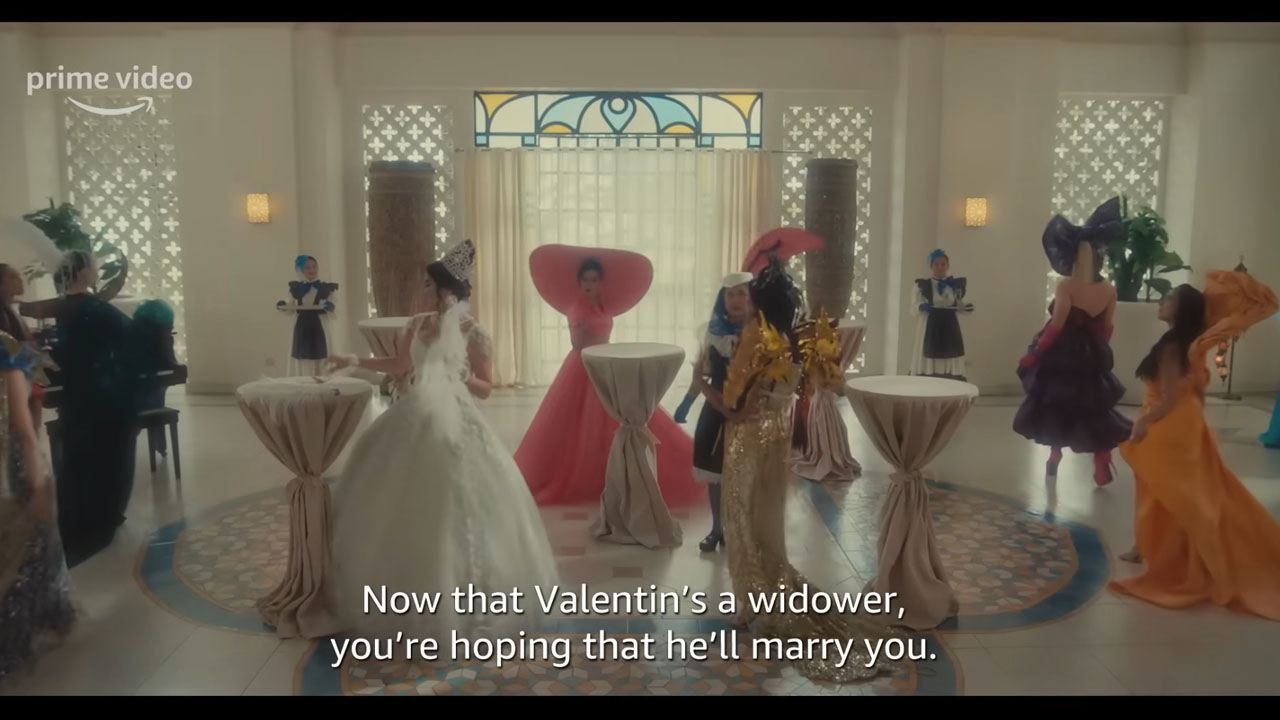
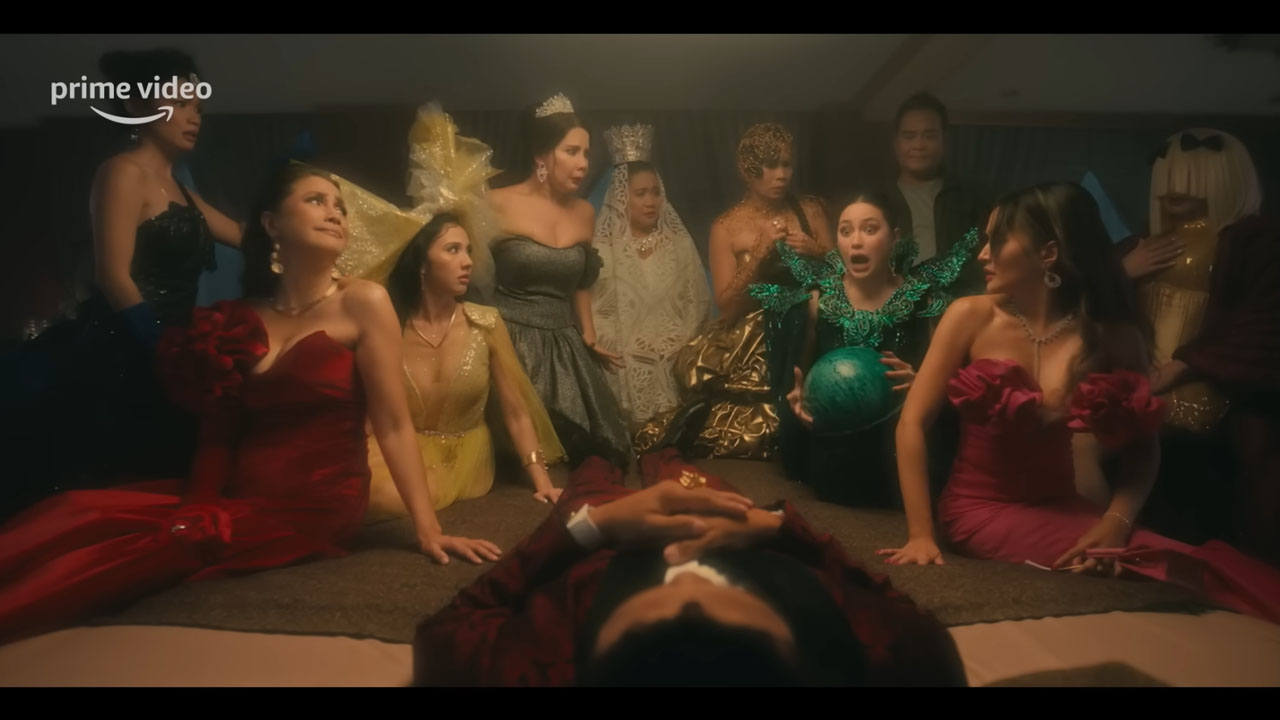



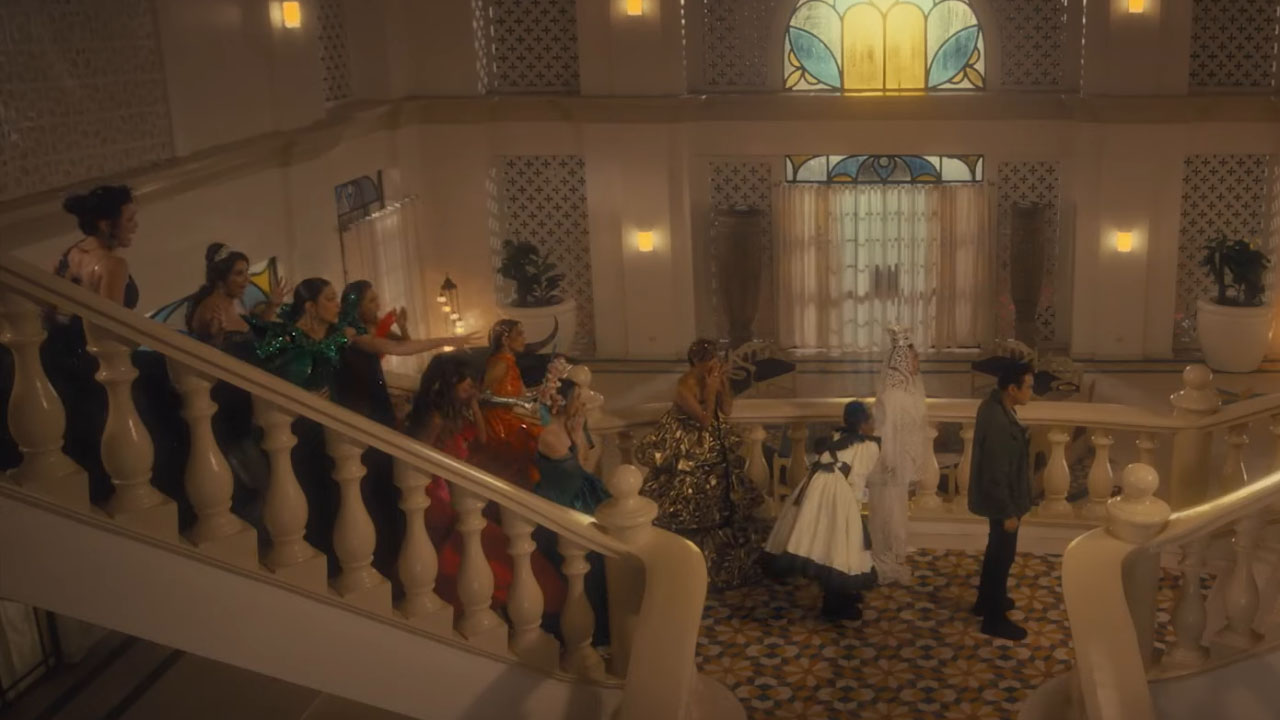


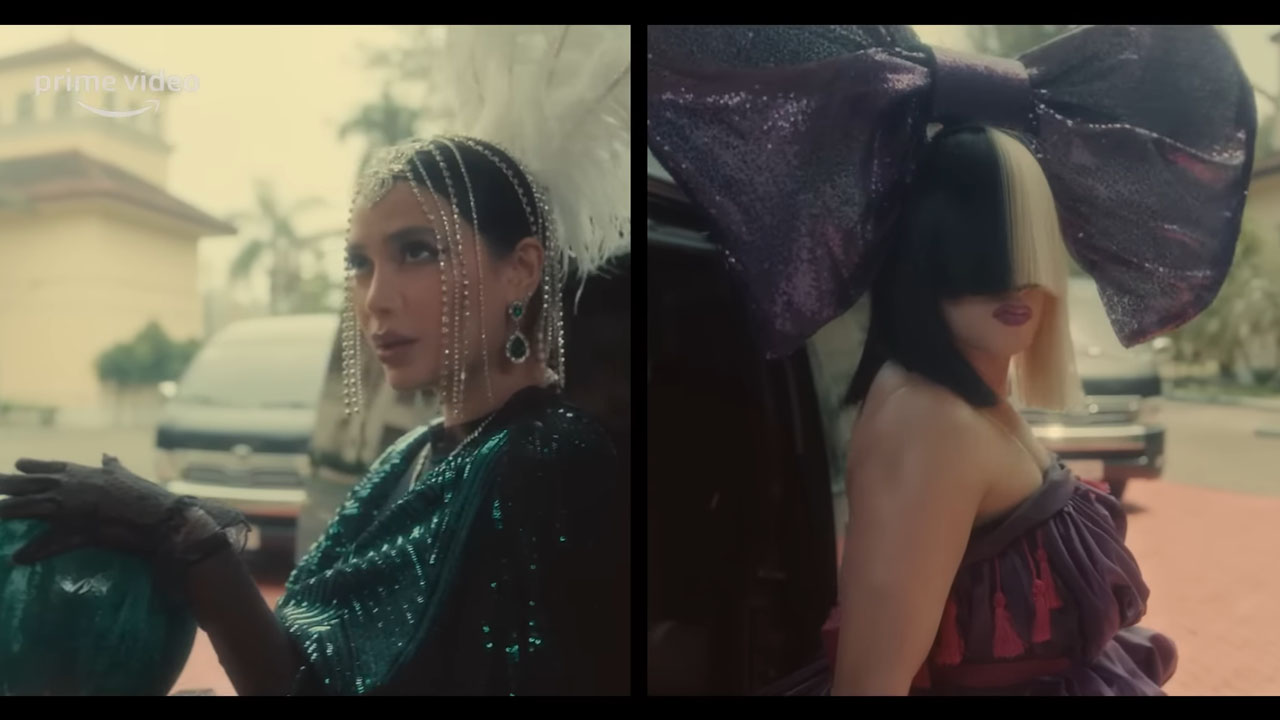



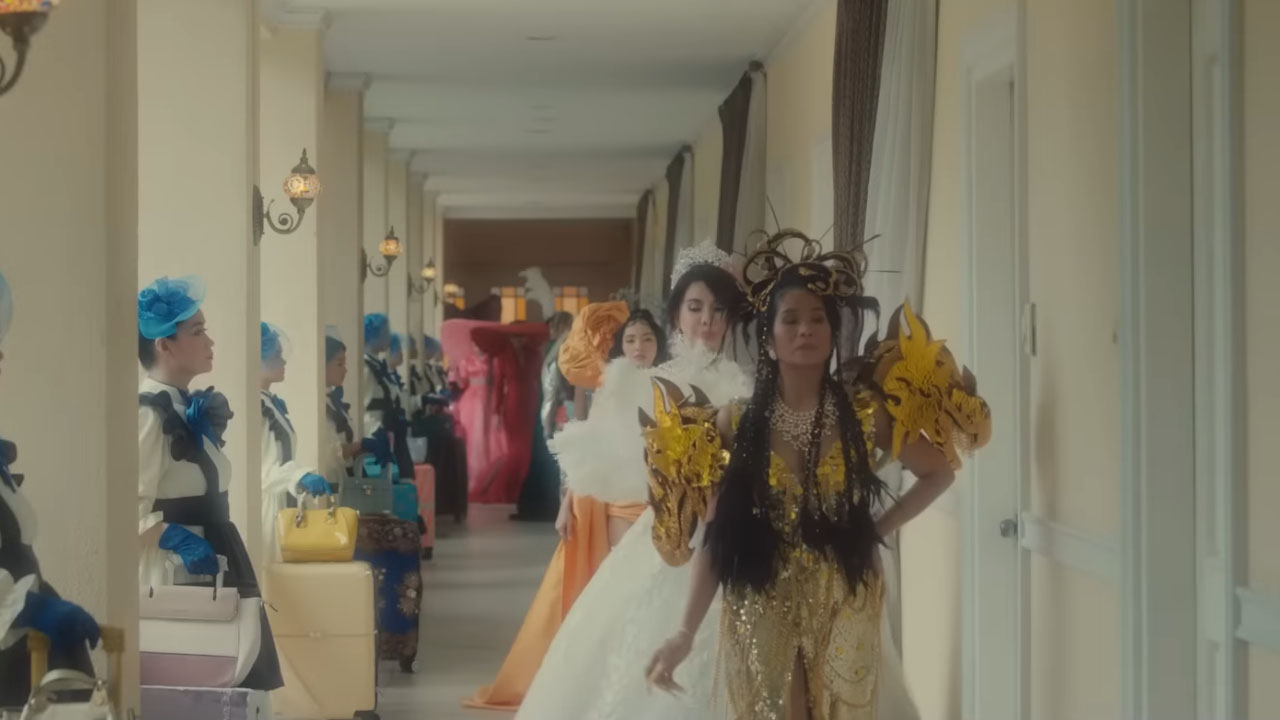
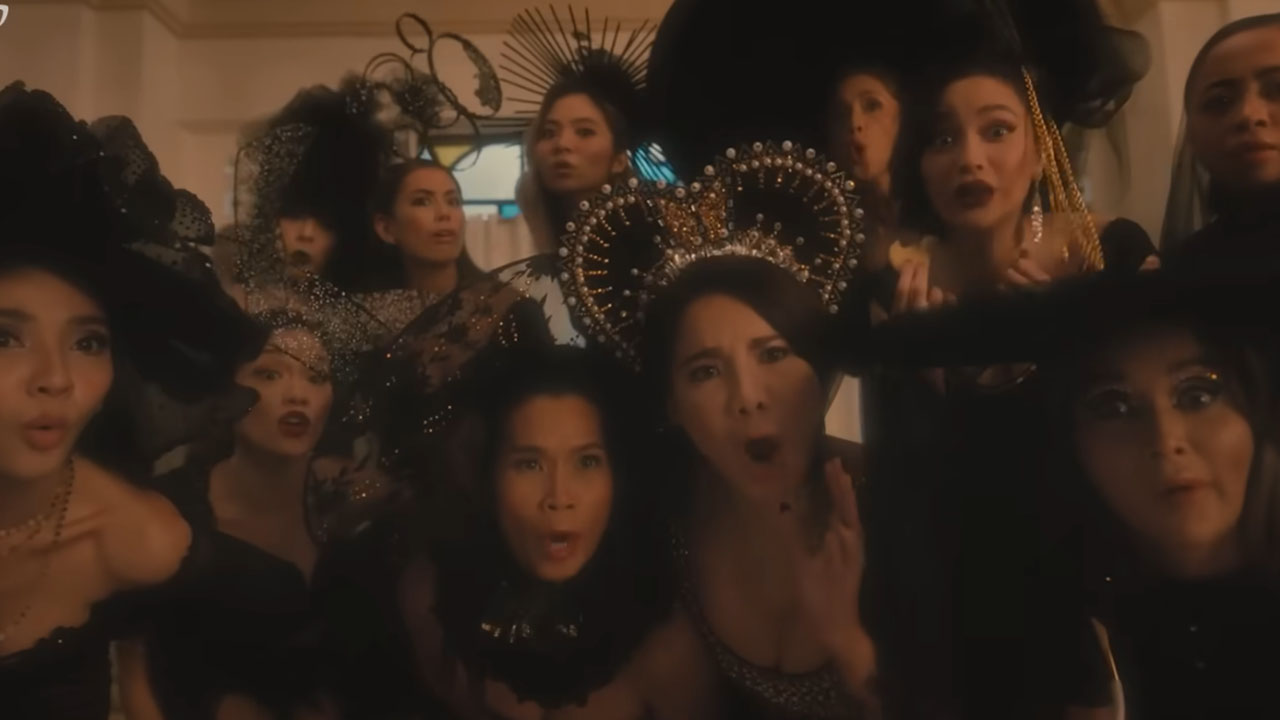



Pingback: Takeshi’s Castle Returns With Modern Take On Mayhem – What's A Geek